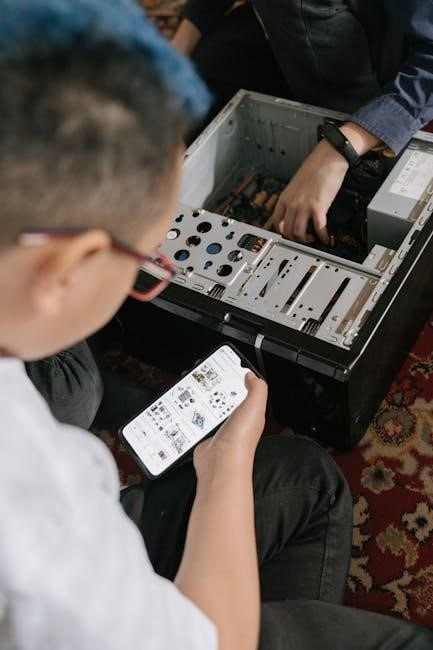Ducane furnace troubleshooting is essential for maintaining efficient heating and ensuring safety. This guide covers common issues, DIY solutions, and when to call a professional. Regular maintenance can prevent many problems, but expert intervention is sometimes necessary for complex faults.

Common Furnace Issues
Ducane furnaces often face ignition troubles, heating problems, and blower motor malfunctions. These issues can stem from faulty sensors, worn-out parts, or improper calibration. Regular maintenance and timely repairs are crucial to ensure optimal performance and safety.
Ignition Troubles
Ignition issues in Ducane furnaces are common and can prevent the system from heating properly. Faulty igniters, clogged burners, or gas supply problems often cause these troubles. If the igniter fails to light, the furnace won’t operate, leading to cold conditions. Users may notice clicking sounds or a glowing igniter that doesn’t ignite the gas. Cleaning the burners and ensuring proper gas flow can resolve some issues. However, if the igniter is damaged, replacement is necessary. It’s crucial to handle these repairs carefully to avoid safety hazards. Consulting a professional is recommended if DIY solutions don’t work, as improper fixes can lead to further complications or safety risks.
Heating Problems
Heating issues with Ducane furnaces can result in inadequate warmth or complete system failure. Common causes include faulty thermostats, blocked air vents, or malfunctioning heat exchangers. If the furnace doesn’t heat properly, check for clogged filters or damaged ductwork. In some cases, the pilot light may not stay lit, requiring adjustment or replacement. Ignition troubles can also lead to heating problems, as the burners may not fire correctly. DIY solutions include cleaning vents and ensuring proper airflow, but severe issues like a cracked heat exchanger demand professional attention. Regular maintenance, such as filter replacements and duct inspections, can prevent many heating-related problems. Always prioritize safety when addressing these issues, as improper repairs can lead to carbon monoxide leaks or fire hazards. If the furnace consistently underperforms, upgrading to a newer model might be necessary. Stay proactive with routine checks to ensure reliable heating performance during cold weather.

Blower Motor Malfunctions

Blower motor issues can cause poor airflow or loud noises. Common problems include worn bearings, faulty capacitors, or wiring issues. Regular maintenance, like lubricating parts and checking connections, can prevent failures. Replace the motor if damage is severe.

Motor Failure
Motor failure in a Ducane furnace can lead to complete system shutdown, leaving your home without heat. This issue often stems from worn bearings, overuse, or electrical faults. If the motor stops working, the furnace cannot circulate air, causing heating problems. Early signs include unusual noises, such as grinding or screeching, and reduced airflow. Inspect the motor for visible damage or debris buildup. Check the capacitor for failure, as it may prevent the motor from starting. If the motor is damaged beyond repair, replacement is necessary. Always ensure proper installation and sizing to avoid future issues. Regular maintenance, like lubricating bearings and cleaning filters, can extend the motor’s lifespan. However, if the problem persists, consult a professional HVAC technician to diagnose and repair or replace the motor effectively. Remember, a faulty motor can increase energy bills and reduce system efficiency, making timely resolution crucial for optimal performance.
Abnormal Noises

Abnormal noises from your Ducane furnace can indicate underlying issues that need immediate attention. Common sounds include rattling, clunking, or whistling, which may signal loose parts, internal damage, or airflow problems. Rattling noises could mean debris in the furnace or ducts, while clunking often points to failing internal components. Whistling sounds typically suggest airflow restrictions, such as clogged filters or vents. Ignoring these noises can lead to further damage or safety hazards. To address the issue, inspect the furnace for loose screws or debris and ensure filters are clean. If the noise persists, it may indicate a more serious problem, such as a failing heat exchanger or blower motor. In such cases, turning off the furnace and contacting a professional is essential to avoid potential safety risks. Regular maintenance can help prevent these issues, but prompt action is crucial when unusual noises arise. Always prioritize safety and efficiency by addressing abnormal sounds promptly.

Thermostat-Related Problems
Thermostat issues can disrupt furnace operation, causing temperature fluctuations. Faulty wiring, miscalibrations, or sensor malfunctions often lead to inconsistent heating. Check connections, ensure calibration accuracy, and replace batteries if necessary. Faulty thermostats may require professional replacement to restore proper functionality and comfort. Regular checks prevent such issues.
Calibration Issues
Calibration issues with your Ducane furnace thermostat can lead to inaccurate temperature readings, causing uneven heating or system malfunctions. Over time, wear and tear or environmental factors may disrupt the thermostat’s calibration. Signs include inconsistent heating, frequent cycling, or the furnace not turning on. To address this, ensure the thermostat is properly leveled and free from obstructions. Check the wiring connections for any damage or corrosion. If issues persist, recalibrating the thermostat or replacing it might be necessary. Refer to the user manual for specific recalibration steps or consult a professional if unsure. Regular maintenance can prevent such problems, ensuring optimal furnace performance and energy efficiency. Proper calibration is crucial for maintaining comfort and extending the lifespan of your heating system. Always follow safety guidelines when handling electrical components to avoid further complications.
Sensor Malfunction
A sensor malfunction in your Ducane furnace can disrupt its operation, leading to safety issues or inefficient heating. Common sensors include the flame sensor, limit switch, and pressure sensor, which monitor critical functions. If these sensors fail or become dirty, the furnace may shut down unexpectedly or fail to ignite. Symptoms include error codes, uneven heating, or the furnace not turning on. Regular cleaning of sensors, such as gently brushing the flame sensor, can resolve some issues. However, if the problem persists, it may indicate a faulty sensor requiring replacement. Always turn off power before attempting any repairs. If you’re unsure, consult a professional to avoid safety risks or further damage. Proper sensor function is vital for ensuring your furnace operates safely and efficiently. Addressing sensor malfunctions promptly can prevent more severe problems and extend the lifespan of your heating system. Remember to follow manufacturer guidelines for maintenance and repairs to ensure optimal performance.

Error Codes and Their Meanings
Ducane furnace error codes indicate specific issues, helping diagnose problems like ignition failures or sensor malfunctions. Each code corresponds to a particular fault, guiding troubleshooting efforts. Refer to your user manual or contact a technician for detailed solutions and repairs.
E1 Code
The E1 code on a Ducane furnace typically indicates an ignition failure. This means the furnace is unable to light the burner properly. Potential causes include a faulty igniter, blocked gas valves, or issues with the gas supply. To troubleshoot, first check if the gas valve is open and ensure there are no obstructions in the burner area. If the igniter is damaged, it may need replacement. Additionally, dirty or corroded parts can prevent proper ignition, so cleaning or replacing them might resolve the issue. If the problem persists after these steps, it’s recommended to consult a professional HVAC technician to avoid safety hazards and ensure proper repair. Regular maintenance can help prevent such issues from occurring in the future.
E2 Code
The E2 code on a Ducane furnace indicates a problem with the pressure switch or related components. This code suggests that the pressure switch is stuck in the closed position, preventing the furnace from operating. Common causes include a blocked vent system, dirty or faulty pressure switches, or obstructions in the flue. To troubleshoot, inspect the vent pipes for blockages or damage and ensure they are properly connected. Clean or replace the pressure switch if it’s dirty or malfunctioning. Additionally, check for any signs of wear or corrosion in the switch or its wiring. If the issue persists after these steps, it may require professional attention to ensure safe and proper repair. Regular maintenance can help identify and address such issues before they lead to system failures, promoting efficient and reliable heating performance.


Safety Precautions
Always turn off power and gas before servicing your Ducane furnace. Wear protective gear and ensure proper ventilation. Never attempt repairs without following manufacturer guidelines. Carbon monoxide leaks and gas hazards require immediate professional attention to ensure safety and prevent accidents.
Gas Leak Symptoms
A gas leak in your Ducane furnace can be dangerous. Common signs include a strong, unpleasant odor similar to rotten eggs, hissing sounds near gas lines, or a yellowish flame instead of a blue one. If you suspect a leak, open windows for ventilation, avoid sparks, and shut off the gas supply immediately. Never ignore these symptoms, as they can lead to explosions or carbon monoxide poisoning. Check for soot staining around vents or pipes, which may indicate a leak. If unsure, contact a certified HVAC technician to inspect and repair the system. Regular maintenance can help prevent gas leaks by ensuring all connections are secure and components are functioning properly. Always prioritize safety when dealing with gas-related issues to protect your home and family.
CO Detection Tips
Carbon monoxide (CO) detection is critical for safety when troubleshooting your Ducane furnace. Install CO detectors on every level of your home, especially near sleeping areas. If the alarm sounds, evacuate immediately and call emergency services. Look for symptoms like headaches, dizziness, or nausea, which can indicate CO exposure. Inspect your furnace annually for proper ventilation and check for blockages in vents or flues. Ensure all gas connections are tight and free from leaks. Replace worn-out gaskets or seals to prevent CO leaks. Use a CO detector with a digital display for accurate readings. Never ignore unusual odors or soot buildup, as they can signal CO issues. Keep emergency contacts handy and educate household members on CO risks. Regular maintenance by a certified technician can help prevent CO hazards. Stay vigilant to protect your family from this silent threat.
